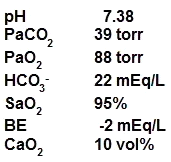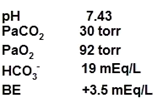Registered Pulmonary Function Technologist v1.0
Question 1
During a bronchial provocation study, a patient has the following spirometric values after a 0.25 mg/mL dose of methacholine:

Based on these results, a pulmonary function technologist should
- A. Instruct the patient to blow out longer and repeat the effort.
- B. Stop the test and immediately administer a bronchodilaior.
- C. Instruct the patient to blow out harder and repeat the effort.
- D. Reduce the concentration of methacholine on the next trial.
Answer : A
Question 2
A body plethysmograph box pressure transducer fails the electronic calibration check after multiple attempts. Which of the following should a pulmonary function technologist do?
1. Perform a biologic control test
2. Inspect the door seal.
3. Re-zero the box pressure transducer.
4. Perform a physical pressure calibration.
- A. 1, 2, and 4 only
- B. 1, 3, and 4 only
- C. 2, 3, and 4 only
- D. 1, 2, and 3 only
Answer : D
Question 3
In a patient with neuromuscular disease, which of the following is the best way to detect airway obstruction?
- A. SGaw
- B. MIP
- C. PEF
- D. MVV
Answer : D
Question 4
While setting up an exercise laboratory in a city with an altitude of 8,600 ft (2,775 m), a pulmonary function technologist notices the fuel cell O2 analyzer is displaying 15.2%. Which of the following is the best explanation for this finding?
- A. This exercise system will not work at high altitude.
- B. The analyzer is responding to P1O2.
- C. F1O2 decreases with increasing altitude.
- D. The fuel cell needs to be changed.
Answer : B
Question 5
An arterial blood gas performed prior to exercise on a 45-year-old patient shows the following results:

A pulmonary function technologist should conclude that the patient's
- A. Hemoglobin level is below normal.
- B. Values are within normal limits.
- C. Alveolar ventilation is above normal.
- D. Dead space ventilation is above normal.
Answer : A
Question 6
While performing a quality control test on an open circuit nitrogen system, the volume of a 3-liter syringe is measured as 3.9 L. Which of the following is the most probable explanation?
- A. There was an air leak in the system.
- B. The initial O2 concentration in the syringe was greater than 0.21.
- C. The volume was not corrected from ATPS to BTPS.
- D. The nitrogen analyzer gain was set too low.
Answer : A
Question 7
A 12-year-old patient completed an evaluation for exercise-induced asthma in the pulmonary function laboratory. The patient completed six minutes of exercise on a treadmill with a heart rate of 145 to 150/min. The following spirometry data were collected:

A pulmonary function technologist should conclude that the exercise test is
- A. Inadequate workload with a positive response
- B. Adequate workload with a negative response
- C. Inadequate workload with a negative response
- D. Adequate workload with a positive response
Answer : D
Question 8
A polarographic oxygen analyzer used to measure expired gas in a metabolic system should always be calibrated with
- A. Gas concentrations higher and lower than the expected measurement
- B. Oxygen mixtures containing 4% and 8% carbon dioxide
- C. 100% oxygen and 100% nitrogen, fully saturated
- D. Air and fully saturated 100% oxygen.
Answer : A
Question 9
Which of the following information reported from a recent methacholine challenge test best summarizes the patient's bronchial hyperresponsiveness?
- A. patient reported chest tightness and a cough
- B. diluent FEV1 = 92% predicted
- C. postbronchodilator recovery FEV1 = 106% baseline
- D. PC20 = 2.3 mg/mL
Answer : A
Question 10
The following blood gas report is questioned by the attending physician:

Which of the following values is INCONSISTENT?
- A. BE
- B. pH
- C. PaCO2
- D. HCO3
Answer : A
Question 11
The following results were obtained from a symptom-limited exercise (stress) test:

Which of the following is true regarding these data?
- A. The patient is deconditioned.
- B. The patient has a cardiac limitation to exercise.
- C. The patient reached the anaerobic threshold.
- D. The patient has a pulmonary limitation to exercise.
Answer : B
Question 12
The following data are obtained for a 60-year-old male undergoing an exercise (stress) test on an ergometer:

A pulmonary function technologist should
- A. Stop the test because the blood pressure response is abnormal.
- B. Stop the test because the heart rate is too high after 10 minutes.
- C. Stop the test because this is an abnormal VD/VT response.
- D. Continue the test since this is a normal cardiopulmonary response.
Answer : A
Question 13
The normal response to an increasing PaCO2 is
- A. To maintain a constant VE until the PaCO2 exceeds 55 torr.
- B. A decrease in VE of 2to5L/min/torrPCO2.
- C. An increase in VE of 1 to 6 L/min/torr PCO2.
- D. An increase in VE of 10to15L/min/torrPCO2.
Answer : C
Question 14
During an exercise (stress) test, the minute ventilation to carbon dioxide production (Ve /VCO2) ratio is 100. This measurement indicates
- A. Severe pulmonary hypertension
- B. A normal response
- C. Equipment malfunction
- D. Increased work of breathing
Answer : C
Question 15
The desiccant column on an infrared CO2 analyzer is pink. The readings obtained from this analyzer would result in
- A. A decreased CO2
- B. An increased CO2
- C. An unstable reading
- D. No effect on CO2
Answer : B